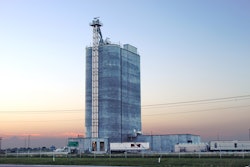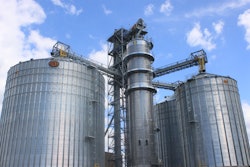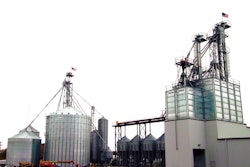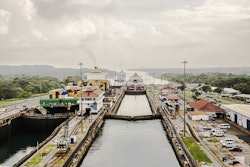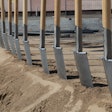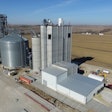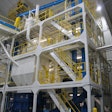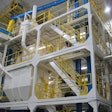The year 2014 ended as a mixed bag on the transportation front. Historically poor railroad performance in the Northern Plains and record-high costs for railcars were detrimental to many grain shippers. But on the bright side, Congress’ passage of the Waterways Resources Reform and Development Act recognized the importance of maintaining vital waterways like the Mississippi River.
Updated infrastructure and smooth logistics are critical to keep U.S. transportation costs down, and its competitive edge sharp.
“There’s not a lot that we produce, especially in grains, that buyers couldn’t get from somewhere else in the world if we weren’t competitive and reliable,” said David Salmonsen, American Farm Bureau trade specialist. “We’re entering an era where currency values are changing, and the U.S. dollar and exports are a little more expensive in foreign markets. We need all the transportation cost advantages we can get to help offset the increasing prices for our products in export markets.”
For that reason, both the government and industry are significantly investing in rail and river transportation improvements, as well as enacting new ways to fund crucial waterway projects going forward.
Railroads ramp up investment
A variety of circumstances, including harsh winter weather in 2013/2014 and concentrated growth in railcar demand, set the stage for historically late rail service for many grain shippers. In May 2014, BNSF, America’s largest grain mover by rail, averaged about 14,000 past due cars and an average days late of about 26. John Miller, BNSF agricultural products group vice president, explained that this was the result of unexpected growth in the Northern region.
“Growth beginning in 2009 and into 2010 was centered on BNSF’s Great Northern corridor, with volume increases occurring in bulk commodities. The Northern lines were able to flex up to volume increases, but were not built to stay that way for extended periods of time. This change in growth pattern, coupled with the harshest winter in many years, resulted in deteriorating service levels becoming most acute in late 2013 and continuing into 2014. The end result was a situation where we were unable to fully meet the shipping demands of our customers.”
BNSF responded to its shortcomings with a $5.5 billion investment in 2014 to bolster its locomotive fleet, purchase railcars, add personnel, expand its facilities and add more track. Many of the nation’s other top railroads also made significant capital investments last year, such as laying new railroad tracks and putting faster locomotives and additional railcars into service. (Read about the industry’s investments in the “Rail Transportation Spotlight” sidebars.)
These investments and overall good weather played a role in improving rail performance in 2015. According to USDA, rail shipments of grain are up 20% from the three-year average and according to the Association of American Railroads, for the four weeks ending March 7, total weekly U.S. Class I Railroad grain car loadings were up 10% from last year and up 11% from the three-year average.
Meanwhile, transportation costs for rail are back to normal rates from the all-time high in May 2014 of $400/car for a shuttle on the secondary market. By mid-March 2015, the USDA reported the price at $200/car.
“The cost of railcars in an important secondary market has tumbled, a sign that shippers are confident that cars will arrive when they are needed,” said Miller.
Waterways gain crucial funding
While poor rail service hindered grain shippers in the Northern Plains, river infrastructure continued to be the main concern in other parts of the country. The Mississippi River is a vital artery for grain shippers moving product from the Midwest to the Gulf of Mexico. For many years, the grain industry has been vocal about the need to update some of the river’s nearly 100-year-old locks and dams.
“We need to make more investment to maintain what we have and to upgrade it,” said Mike Toohey, president of the Waterways Council, Inc. “The world is coming to the breadbasket of America for its food stocks and we need to be ready.”
Recognizing this need, Congress passed the Waterways Resources Reform and Development Act (WRRDA). WRRDA contains several provisions that increase funding levels for the Inland Waterways Trust Fund (IWTF).
“The [IWTF] funds are used for major rehab and replacement of navigation infrastructure projects which have an approved Rehabilitation Evaluation Report and have been prioritized and approved by the Inland Waterway Users Board,” said Andy Schimpf, P.E., St. Louis District navigation manager, U.S. Army Corps of Engineers.
Schimpf said the IWTF receives roughly $90 million from a tax on fuel purchased by vessels using the inland waterways, while another matching $90 million is put into the trust fund from the treasury and the sum draws interest.
The passage of WRRDA enacted an increase in the user fuel tax from 20 to 29 cents/gallon beginning in April 2015.
“The 9-cent increase, when matched with General Treasury Funds, will inject around $80 million annually into the IWTF,” said Andrew Walmsley, transportation specialist for the American Farm Bureau.
Toohey said the Waterways Council, Inc. asked Congress to use some of the IWTF to support the Navigation and Ecosystem Sustainability Program (NESP), which would invest $2.1 billion to upgrade locks on the Illinois and Mississippi Rivers to 1,200-foot capacity — the current industry standard.
“[With the 1,200-foot capacity], vessels wouldn’t have to break up the tows to go through the locks like they do now,” said Toohey. “They would simply pull up, lock through, and keep going, which would lower the cost of transportation to the grain industry.”
Toohey’s confident Congress will approve the request to fund NESP, but before any new projects can get off the ground, the Army Corps of Engineers must first finish ongoing updates, including the Olmsted Locks & Dam. This upgrade will replace two existing locks on the border of Illinois and Kentucky on the Ohio River. The project was authorized by Congress in 1988 and has gone more than two billion dollars over budget, taking up a significant portion of the IWTF budget.
The good news is that provisions passed in WRRDA removed the burden of funding this massive project from the IWTF.
“Because the Olmsted Locks and Dam [project] was so over budget due to an engineering experiment, Congress agreed to federalize that project (85% Federal funding, 15% IWTF) and take the money that would’ve come out of the trust fund and put it toward other projects,” said Toohey. “Two other priorities are projects that were started and then stopped on the Tennessee River, so once those are underway, the money will begin to flow to the Upper Mississippi and Illinois NESP.”
Panama Canal to increase river traffic
Another reason to invest in Mississippi River infrastructure is the expected increase in traffic from the expansion of the Panama Canal. The canal is anticipated to open later this year, and will lead to a 12% decrease in the cost of transporting grain from the U.S. Corn belt to Asia, according to Rabobank projections.
“The expanded Panama Canal will broaden the area where it’ll be more economical to ship by river than ship by train on each side of the Mississippi,” Salmonsen said. “Being able to load the bigger ships and get those economies of scale through the gulf ports with the Panama Canal to Asian markets will be a big reason for grains to increase their use of the river.”
The upgrades planned for U.S. waterways and railways will help preserve one of the United States’ most competitive advantages to foreign buyers — affordable transportation costs.
“Having [infrastructure] that is reliable provides us with the transportation services we need to keep and expand foreign markets,” said Salmonsen. “And that’s why investment in transportation is so important to everyone in agriculture.”
Rail Transportation Spotlight: CSX RAILWAY
The $1 billion CSX Agriculture business represents about 9% of the company’s overall business. The agriculture market as a whole increased 7% year-over-year in 2014, with strong gains in feed ingredients and feed grain.
Recent investments
CSX has invested nearly $21 billion into track, rolling stock and facilities since 2003. In the past decade, CSX has invested more than $200 million in its Southeast Corridor and another $95 million in a new unit train inspection yard in Kentucky, which will assist with expediting the movement of agricultural unit trains. CSX also continues to invest in its fleet of covered hoppers, adding 500 new large capacity cars in 2014 and a total of more than 2,100 new hoppers since 2008.
Plans for 2015
CSX has a $2.5 billion investment plan for 2015. Its maintenance-of-way plan includes the replacement or installation of 510 track miles, 3 million tons of ballast, and 3.25 million wood crossties. CSX also purchased 300 new locomotives to be delivered in 2015 and 2016. In addition, the company has accelerated its heavy rebuild program to bring additional power back into the active fleet.
In Q1 of 2015, CSX put 400 more locomotives in its active fleet than in 2014. Between new locomotives and rebuilds, the company expects to bring another 150 units onto the network in the first half and 200 more units in the second half. To ensure those units remain in active service, CSX is also investing in locomotive shop capacity along the Northern Tier and Southeast Corridor, including a new locomotive shop in Chicago and additional labor and facilities enhancements at Buffalo, Cincinnati, Nashville and Selkirk, NY.
Rail Transportation Spotlight: Union Pacific
In 2014 agricultural products shipments made up 17% of overall freight revenue for Union Pacific. UP’s Ag Products volume was up 4% in the fourth quarter of 2014 vs. 2013, and grain car loadings were up 3% in the fourth quarter.
Recent investments
In 2014, major growth investments from its $4.1 billion capital spend included the completion of the Santa Teresa, NM, facility, as well as the Tower 55 project in Fort Worth, TX. Both alleviated key bottlenecks to enhance velocity and support customers throughout the UP network.
Plans for 2015
In 2015, UP plans to invest $4.3 billion to support customer needs, including $1.085 billion for infrastructure replacement, $1.075 billion for locomotives/equipment — including 800 freight cars and 218 locomotives, $700 million for capacity/commercial facilities, $450 million for Positive Train Control and $225 million for technology and other spending.
Rail Transportation Spotlight: BNSF
In 2014, BNSF hauled nearly 1 million carloads of agricultural commodities, with agricultural products making up approximately 10% of its shipping volume. These products include wheat, corn, ethanol, soybeans, feeds and specialty grains.
Recent investments
In 2014, it added 613 locomotives and approximately 7,500 railcars, and more than 7,000 people joined the BNSF team. Along its Northern Corridor, BNSF added 55 miles of new double-track along the Glasgow Subdivision, which runs between eastern Montana and western North Dakota, in addition to 21 miles of double-track on the Lakeside Subdivision, which runs through eastern Washington.
Plans for 2015
BNSF planned $6 billion in capital expenditures for 2015 to meet its customers’ ever-growing freight shipment demands. The 2015 capital plan includes $2.9 billion to replace and maintain core network and related assets, nearly $1.5 billion on expansion and efficiency projects and $1.4 billion for locomotives, freight cars and other equipment acquisitions. BNSF plans to acquire approximately 330 locomotives and approximately 7,800 railcars. Building on progress made in 2014, 129 miles of double-track will be added to the network in 2015. In addition to the physical infrastructure, Centralized Traffic Control will be added to more than 800 miles of the network to support more efficient train flows. This state-of-the-art technology will more efficiently and effectively control train movements by decreasing the reliance on manual processes in favor of a centralized, automated approach.
Rail Transportation Spotlight: Norfolk Southern
Agriculture makes up 8% of total business by volume for Norfolk Southern, who serves agricultural shippers and receivers of corn, wheat, soybeans, miscellaneous grains, animal and poultry feed, ethanol and more.
Recent investments
Norfolk Southern invested $2.1 billion into its network in 2014. Half of this was in infrastructure, facilities and maintenance-of-way projects; 28% in rolling stock; and the remainder in technology, Positive Train Control development, and other projects.
NS has made significant investments in network capacity improvements including more than $750 million to increase capacity along its high-volume Chicago-to-Bellevue, OH, corridor. This includes a $160 million expansion of the railroad’s Bellevue classification yard with 39 miles of new track in the yard. The expansion will add capacity to its Northern Region as well as improve the fluidity of its network by reducing car handling, car miles, and transit times. More capacity at the yard will open up space at other terminals, thus improving asset utilization. Some customers could see transit times improve by 1 to 2.3 days.
Plans for 2015
Norfolk Southern’s capital budget for 2015 is $2.4 billion, 13% higher than in 2014. The improvements will help maintain the safety and quality of its rail network, enhance service, improve operational efficiency, and support growth opportunities for NS and its customers. The plan includes $1.3 billion for rail, ties, ballast, bridges, infrastructure and facility improvements, $642 million for rolling stock and $484 million for Positive Train Control, technology and other investments.




